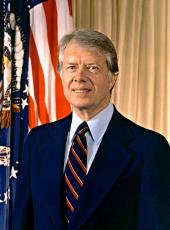By the President of the United States of America
A Proclamation
The white cane, an ingeniously simple device in an age of complex technology, helps assure that those with impaired or lost vision can lead rich and useful lives.
Remarkable progress in public attitudes toward blindness has been made in recent years. It is now widely understood that blindness need not be a barrier to full participation in social and economic life, and the white cane is responsible for some of this progress.
Nevertheless, in certain situations--on a busy street, near construction sites, or wherever there are unusual obstacles or hazards--a white cane user may still need help. Yet some people may be reluctant to offer it, for fear of saying or doing the wrong thing. Most blind people understand this hesitancy and are glad to explain their needs if they are asked.
The white cane also signals to motorists and cyclists that the user is blind--but it cannot signal the user that a vehicle is approaching. Thus it is the driver's responsibility to exercise extra caution.
To heighten public awareness of the importance of the white cane to the independence and safety of thousands of blind and visually handicapped Americans, the Congress, by a joint resolution approved October 6, 1964 (78 Stat. 1003' 36 U.S.C. 169d), has authorized the President to proclaim October 15 of each year as White Cane Safety Day.
Now, Therefore, I, Jimmy Carter, President of the United States of America, do hereby proclaim October 15, 1977, as White Cane Safety Day.
In Witness Whereof, I have hereunto set my hand this twenty-ninth day of September, in the year of our Lord nineteen hundred seventy-seven, and of the Independence of the United States of America the two hundred and second.

JIMMY CARTER
Jimmy Carter, Proclamation 4528—White Cane Safety Day, 1977 Online by Gerhard Peters and John T. Woolley, The American Presidency Project https://www.presidency.ucsb.edu/node/242521

